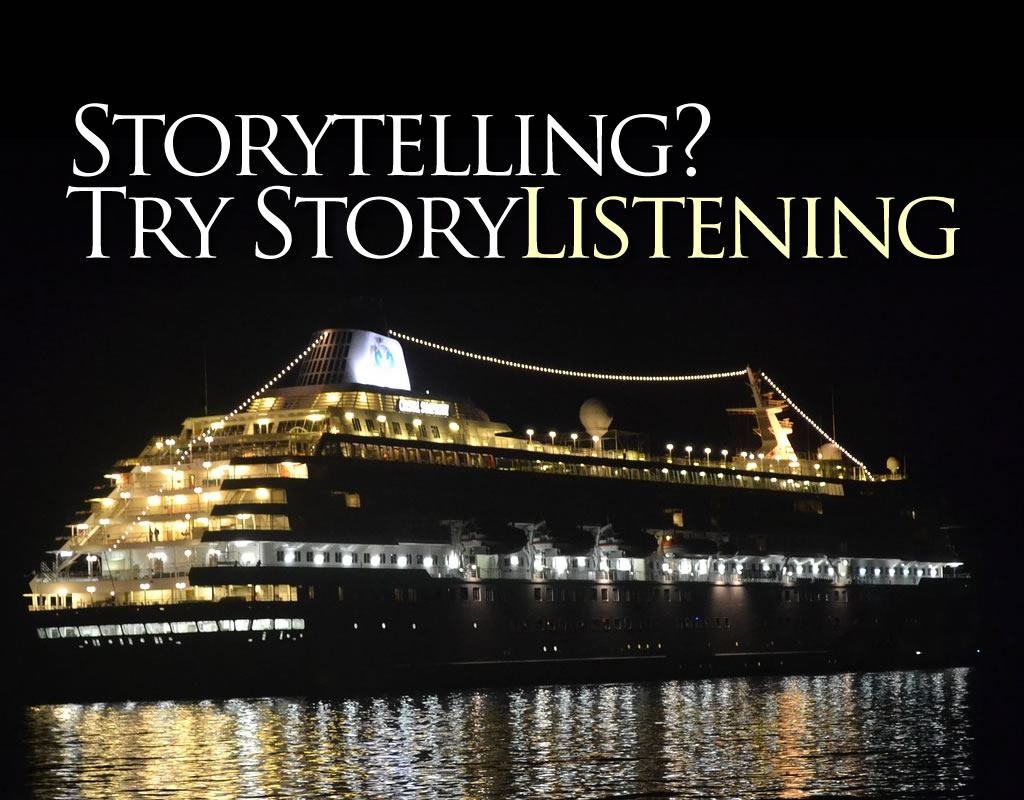Be an Effective Storyteller. Try Story Listening

Storytelling is a powerful tool, but no one ever talks about story listening.
Have you ever been with a friend, family member, client, or colleague and assumed they were thinking and feeling something completely different from what they actually were? People in the exact same place at the exact same time can have dramatically different experiences. (I think anyone who’s ever been in a relationship can attest to that.) If you want to connect, engage, and influence, listening—not talking is the most important ingredient.
Story Listening: Sailing the Gulf Stream
In January of 1992, I was sailing from the Bahamas to Miami. I left just before sunset, planning to sail through the night. The wind was moderate and for the first six hours, I sailed comfortably toward my destination. Gradually the wind increased and the temperature dropped. The wind increased again and the temperature dropped some more. The seas grew excrementally. Soon, I had warm Gulfstream waves breaking over my boat. The 45-degree air would chill me and then I’d get inundated with bathwater again. In all my years of sailing this was the only time I had ever lashed myself into the cockpit for safety.
With my battery failing and my navigation lights barely lit, I continued on through choppy and disorganized 15-foot seas. At one point, my course intersected with two huge freighters and an enormous cruise ship. I felt like a squirrel crossing a highway. I was sure my tiny boat didn’t show up on their radars in those tall seas. I was close enough to hear the throbbing of the ships’ engines as they passed by.
And then I looked up. Colored lights flashed in the stern of the cruise ship. I heard the muted bass of the music in the disco. I could see people dancing. While I was fighting for survival, those people were fighting to get to the bar for their next margarita. We were having very different experiences in the same place at the same time.
Is it the same for you and your clients? Is it the same for you and your team?
Story Listening: THE Earthquake
Another story: My friend Fabio Marques is a talented speaker from Brazil. He was at Disney Land in Anaheim, California eating at the Crazy Horse restaurant. All of a sudden, the floor started shaking. Plates and dishes crashed to the ground. Decorations fell off the wall. He sat in his chair laughing and enjoying the bucking “crazy horse” ride. Disney sure knows how to put on a show, he thought … until he noticed that everyone else in the restaurant was down on their hands and knees under the tables. This was no Disney roller coaster; this was a magnitude 7.5 earthquake.
Fabio was having a very different experience than the other restaurant patrons—and he was in danger because of it.
Story Listening: Online Advertising
This problem of mismatched stories also affects the world of advertising. How many of the ads you see are annoying? Companies like Facebook and Google spend billions of dollars tracking your clicks and likes so they can serve you relevant ads. Even with all that technology, over half of digital advertising dollars are wasted. Imagine burning half of the $378 billion dollars that were spent on digital ads in 2020.
The average global click-through rate on display ads is less that 2/10 of 1 percent!
How can you fix this?
Everyone’s climbing over each other to share their me story.
My product is faster.
My product is cheaper.
My product is better.
You may have a great business and an amazing message to share, but if you’re selling drinks in a disco while your clients are fighting for survival, story misalignment will cost you big opportunities.
If your business is humming along and an earthquake strikes, you’d better think about your clients’ stories. Smart entrepreneurs own their disasters. In 1982, Tylenol saved their brand by recalling $100 million worth of product—even though the tampering that led to the recall happened after the product had left their hands. Compare that to United Airlines debacles where a patron was beaten and removed from an aircraft. Put your story before your customers’ stories, and you can watch your brand evaporate.
Fortunately, most people are happy to tell you about their needs, challenges, and goals.
They’re tired of people who shout, “listen to me; listen to me.” They’re just waiting for some caring person to ask them to tell their story. The most valuable product you have to offer is your attention.
Ask your customers and colleagues what they care about. Learn their stories. Find out what needs they have. Discover what goals they want to achieve and help them accomplish them.
Listen.


